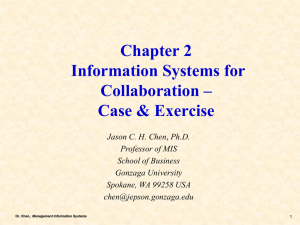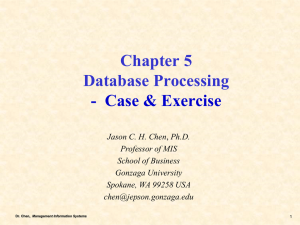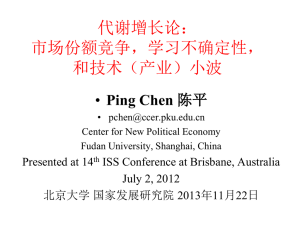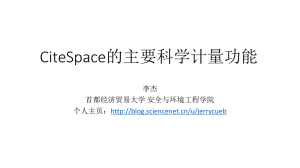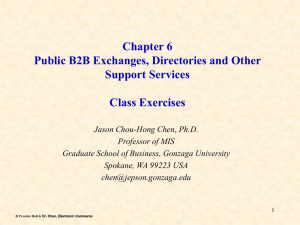Chapter 3 Effects of IT on Strategy and Competition
advertisement
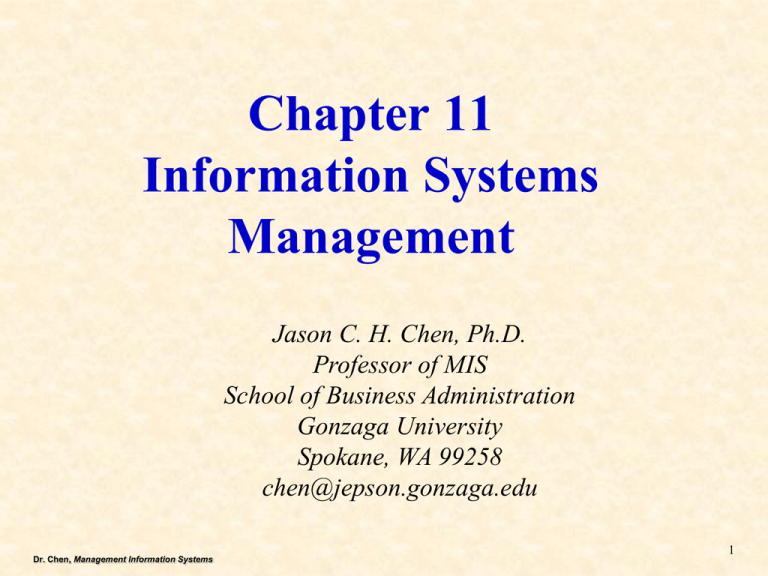
Chapter 11 Information Systems Management Jason C. H. Chen, Ph.D. Professor of MIS School of Business Administration Gonzaga University Spokane, WA 99258 chen@jepson.gonzaga.edu Dr. Chen, Management Information Systems 1 “… You’ve Got a Fox in Charge of a Hen House.” 1. IS management is a mess. 2. New maintenance supervisor oversees IS, but has no IS background 3. IS manager has a conflict of interest 4. Inherited some contractor developed applications. 5. Access to servers is wide open 6. Fox Lake’s general manager needs to get actively involved in IS management Dr. Chen, Management Information Systems 2 Chapter Preview • Information systems are critical to organizational success, and like all critical assets, need to be responsibly managed, in organizations both large and small. • In this chapter, we will survey the management of IS and IT resources. We begin by discussing the major functions and the organization of the IS department. • Then we will consider each of the major functions in greater detail: planning the use of IT/IS, creating and managing the computing infrastructure, creating and managing enterprise IS, and protecting organizational information assets. Dr. Chen, Management Information Systems 3 Chapter Preview (cont.) • The pros and cons of outsourcing and describing some of its risks are presented. • Finally, the chapter concludes with a discussion of the relationship of users to the IS department. In this last section, you will learn both your own and the IS department’s rights and responsibilities. • The goal of the chapter is to give you an appreciation for the scale and complexity of the IS management task and to help you become an effective consumer of IS services. Dr. Chen, Management Information Systems 4 Study Questions • • • • • Q1 What are the functions and organization of the IS department? Q2: How do organizations plan the use of IS? Q3: What are the advantages and disadvantages of outsourcing? (old Q5) Q4: What are your user rights and responsibilities? (old Q6) Q5: 2022? Dr. Chen, Management Information Systems 5 Types of Sourcing _______ _______ _______ Sourcing ___________ Dr. Chen, Management Information Systems 6 Q1: What are the Functions and Organization of the IS Department? • Major functions of information systems department Plan how to use IS to accomplish organizational goals and strategy Manage outsourcing relationships Protect information assets Develop, operate, and maintain organization’s computing infrastructure Develop, operate, and maintain enterprise applications Dr. Chen, Management Information Systems 7 Functions and Organization of the IS Department • Each organization’s IS structure varies depending on these factors: ______ _______ __________ __________ ________ Other factors Dr. Chen, Management Information Systems 8 How is the IS Department Organized? This organizational structure chart shows the typical top-level reporting relationships. Depending on the organization, the Chief Information Officer (CIO) may report to the Chief Executive Officer (CEO), the Chief Operating Officer (COO), or the Chief Financial Officer (CFO). Dr. Chen, Management Information Systems Fig 11-1 Typical Senior-level Reporting Relationships 9 How Is the IT Department Organized? • Chief Information Officer (CIO) Principal manager Reports to CEO, COO, or CFO • Technology office Head: Chief Technology Officer (CTO) Investigates new information systems technologies for possible application at organization • Operations Manages computing infrastructure Dr. Chen, Management Information Systems 10 How Is the IT Department Organized? • Development Manages process of creating new information systems Maintains existing system • Outsourcing relations Handles affairs with outsourced systems • Data administration staff functions Establishes data standards and data management practices and policies Dr. Chen, Management Information Systems 11 INFORMATION SYSTEMS (MIS/IS) Each project team should include the following three types of people: ORGANIZATIONS 1) top/middle management 2) technical professional (e.g., MIS, accounting) 3) USERS Dr. Chen, Management Information Systems Systems Technology Dr. Chen, The Challenge of the Information TECHNOLOGY INFORMATION SYSTEMS MANAGEMENT TM -12 Q/A T/F If an organization does not develop programs in-house, then the development group of the IS department will include programmers, test engineers, and technical writers. Answer: ________ Dr. Chen, Management Information Systems 13 What IS-Related Job Positions Exist? Fig 11-2 Job Positions in the Information Systems Industry Dr. Chen, Management Information Systems 14 What IS-Related Job Positions Exist? (cont’d) Dr. Chen, Management Information Systems 15 What IS-Related Job Positions Exist? (cont’d) Dr. Chen, Management Information Systems 16 IT Position Requirements (Very Important to Your Future Career!) p.390 • Most positions require business knowledge plus technical knowledge • Many require university degrees • Most require good verbal and writing skills • Think dual majors with MIS/CIS to enhance your marketability (competitive advantage) Accounting and information systems Marketing and information systems Management and information systems Operations and information systems HRM and information systems Dr. Chen, Management Information Systems 17 Q2 How Do Organizations Plan the Use of IS? Major IS Planning Functions • The figure below shows the necessary steps an organization must take to plan how it will use IS and IT and to make sure both of them support the organization’s strategy. • The CIO is responsible for most of these items. It’s a never-ending process as organizations change, grow, or merge with other companies. • The steering committee, a group of senior managers from major business functions, works with the CIO to set IS priorities, make decisions about major IS projects, and serve as a communication channel between users and the IS function. Fig 11-3 Planning the Use of IS/IT Dr. Chen, Management Information Systems 18 Explain How You Would Respond to Each Situation. 1. Playing computer games during work hours 2. Playing computer games before and after work hours 3. Responding to emails from an ill parent 4. Watching DVDs during lunch and breaks 5. Sending emails to plan a party that mostly involves people from work 6. Sending emails to plan a party that mostly involves no one from work 7. Updating your Facebook page 8. Reading news on CNN.com 9. Checking stock market over Internet Dr. Chen, Management Information Systems 10. Tweeting friends on your computer about your softball win last night. 11. Selling personal items on eBay 12. Paying personal bills online 13. Paying personal bills online when traveling on company business 14. Buying an airplane ticket for an ill parent over the Internet 15. Changing content of a personal Web site 16. Changing content of a personal business Web site 17. Buying an airplane ticket for a personal vacation over Internet 19 Align Information Systems with Organizational Strategy • As strategies change, as the organization merges with other organizations, as divisions are sold, IS must evolve along with the organization. • Changing a network requires time and resources. Integrating disparate information systems applications is even slower and more expensive. • Without a persuasive CIO, IS can be perceived as a drag on the organization’s opportunities. Dr. Chen, Management Information Systems 20 Q/A Which of the following is a function of the steering committee for an IS department? A) writing program code B) imparting training C) adapting software D) setting IS priorities Answer: ______ Dr. Chen, Management Information Systems 21 Information System Strategy Triangle Strategy Triangle Business (Firm) Strategy Where is the business going and why? Needs and priorities IS/IT Strategy Organizational Strategy What is required? Infrastructure and services How it can be delivered? 1. Architecture/Infrastructure 2. MIS organization 3. Funding 4. Project Management Dr. Chen, Management Information Systems N 22 Information System Strategy Triangle • A business strategy is a well-articulated vision of where the business seeks to go and how it expects to get there. • An organizational strategy is the organization’s design, as well as the choices it makes to define, set up, coordinate, and control its work processes. • IS/IT strategy is the plan the organization uses in providing information systems and services. Dr. Chen, Management Information Systems 23 Communicate Issues to the Executive Group • CIO provides the IS perspective during discussions of problem solutions, proposals, and new initiatives. • For example, when considering a merger, it is important that a company consider integration of information systems in the merged entities. This consideration needs to be addressed during evaluation of merger opportunity. Dr. Chen, Management Information Systems 24 Develop Priorities and Enforce Them Within the IS Department • CIO must ensure that priorities consistent with overall organizational strategy are developed and communicated to IS department. • Must also ensure that IS department evaluates proposals and projects for using new technology in light of those communicated priorities. Dr. Chen, Management Information Systems 25 Sponsor the Steering Committee • Steering committee is a group of senior managers from major business functions that works with the CIO to set IS priorities and decide among major IS projects and alternatives. • Provides a forum where information systems personnel can discuss potential IS initiatives and directions with the user community • Provides a forum where users may express their needs, frustrations, and other issues they have with the IS department Dr. Chen, Management Information Systems 26 Q3. Outsourcing: What and Why? • Outsourcing is the process of hiring another organization to perform a service. Outsourcing is done to save costs, to gain expertise, and to free up management time. • Any value chain business activity can be outsourced • “Your back room is someone else’s front room.” (Peter Drucker) • Drivers (at least four advantages) include: Reducing ________ Transition to new _____________ Focus on _______ business strategies; Provide better management and focus of IT personnel. • Disadvantages are present in outsourcing and include: Losing ________ _________ to undue decisions, etc. Dr. Chen, Management Information Systems 27 Sourcing Decision Cycle Framework • Sourcing involves many decisions (Figure 11 Extra1). • The first step is the make or buy decision. • If buy is selected then the company must decide where. • If the company decides to go offshore it must decide if the offshore company is near or far. • Periodic evaluation must take place. • Continual evaluation is needed to determine if the arrangement is satisfactory or not (either for outsourcing or insourcing). Dr. Chen, Management Information Systems Where? OFFSHORING Where & how the sourcing should be delivered? (distant land) NEARSHORING In or Out of Country? Make or Buy? CAPTIVE CENTER FARSHORING OUTSOURCING BUY (overseas subsidiary) (proximate) INSHORING Status Quo or Change? MAKE Backsourcing INSOURCING FIGURE 11 Extra 1 SOURCING DECISION CYCLE FRAMEWORK Dr. Chen, Management Information Systems Outsourcing Information Systems • Outsourcing, the process of hiring another organization to perform a service, can provide advantages like the ones shown in this figure. • India is the most popular foreign outsourcer because of its large, well-educated, English-speaking population who earn 20 to 30 percent less in labor costs than their U.S. counterparts. International outsourcing is well-suited to 24/7 operations like customer support. Some say outsourcing is a threat to U.S. technology leadership. Dr. Chen, Management Information Systems Fig 11-4 Popular Reasons for Outsourcing IS Services 30 Risk Reduction • Caps financial risk • Ensures certain level of quality, or avoids having substandard quality • Vendor assumes responsibility for hardware, software, network protocol selection, and knowing applicable tax laws • Easier to hire another vendor than to fire and rehire internal staff. Dr. Chen, Management Information Systems 31 International Outsourcing • India Large, well-educated, English-speaking, labor cost 70-80% less than in US. • China and other countries. • Modern telephone technology and Internetenabled service databases • Customer support and other functions operational 24/7. Dr. Chen, Management Information Systems 32 What Are the Outsourcing Alternatives? This figure shows alternatives businesses have for outsourcing some or all of their information system components. Major categories of alternatives by information systems components Oracle, EDS Amazon Salesforce.com Oracle/PeopleSoft Web storefront Employee Travel IaaS: Infrastructure-as-a-Service SaaS: Software-as-a-Service Dr. Chen, Management Information Systems Fig 11-5 IS/IT Outsourcing Alternatives 33 There are a lot of risks to outsourcing information systems as this figure describes. Dr. Chen, Management Information Systems Fig 11-6 Outsourcing Risks 34 Q/A When a company outsources a system, it no longer has control over prioritizing fixes for software failures and problems. Answer: _______ Dr. Chen, Management Information Systems 35 When to Outsourcing? • Which IS activities are strategic to our company's business? 15 percent? • Will outsourcing save us at least ____ • Does our firm have access to the needed technology and expertise? If not, outsourcing may be the answer to acquiring these resources. • Does outsourcing increase our firm's flexibility? 5 years Write shorter contracts - less than ___ Dr. Chen, Management Information Systems INSOURCING What is the example(s) mentioned in the Friedman’s Video (The World is Flat)? Dr. Chen, Management Information Systems Crowdsourcing • Definition: – Taking a task traditionally performed by an employee or contractor, and outsourcing it to an undefined, generally large group of people, in the form of an open call. • Used by companies to increase productivity, lower production costs, and fill skill gaps. • Can be used for a variety of tasks. • Companies do not have control over the people doing the work. • Has cost more than traditional methods. Dr. Chen, Management Information Systems Q4: What Are Your IS Rights and Responsibilities? Fig 11-15 User Information Systems Rights and Responsibilities Dr. Chen, Management Information Systems 39 Q4: What Are Your IS Rights and Responsibilities? (cont’d) Fig 11-15 User Information Systems Rights and Responsibilities Dr. Chen, Management Information Systems 40 Q/A Which of the following is true about the changes and developments foreseen for 2022? A) Licensed, off-the-shelf software will become less configurable, less adaptable, and less flexible. B) Fewer applications will be developed in-house and software customization will become easier. C) Better-skilled employees will be needed to adapt software to increasingly unique organizational needs. D) Small computing devices will become more expensive and lose their popularity. Answer: ______ Dr. Chen, Management Information Systems 41 Q5: 2022? • Hardware infrastructure will migrate to cloud • Licensed, off-the-shelf software more configurable, adaptable and flexible. • iOS devices and other, small computing devices will become cheaper and more popular. • Fewer and less-skilled employees needed • Loss of control of employees’ use of IT Dr. Chen, Management Information Systems 42 • You have certain rights and responsibilities with regard to the IS department that supports you in your job. Here is a list of them. Dr. Chen, Management Information Systems Fig 11-7 User Information Systems Rights and Responsibilities 43 • End of chapter 11 Dr. Chen, Management Information Systems 44


